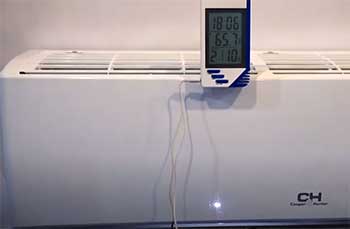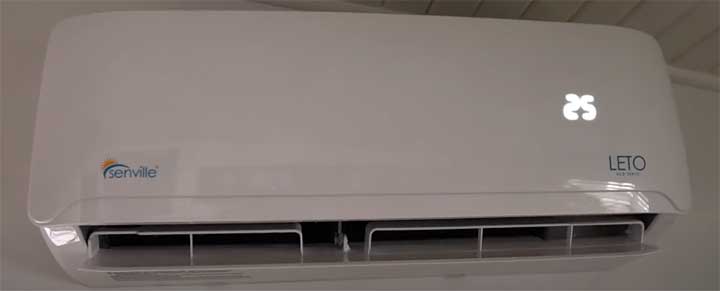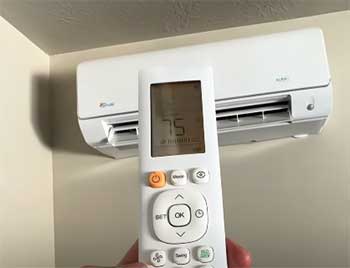Mini split air conditioners have become an increasingly popular option for heating and cooling homes. With their slim, discrete design and energy efficiency, mini splits offer an appealing alternative to bulky central AC systems.
Two of the most recognized brands in mini splits are Cooper & Hunter and Senville. But how do these two brands compare?
Let’s take an in-depth look at the pros, cons, features and reputations of Cooper & Hunter and Senville mini splits.
A Brief Comparison Table
| Comparison Points | Cooper & Hunter | Senville |
| Efficiency Ratings | 16-21 SEER, 8.2-11.2 HSPF | 15-19 SEER, 8-10.5 HSPF |
| Capacity Options | 9k – 36k BTU | 9k – 36k BTU |
| Features | Advanced LCD remote, timer, sleep mode, turbo mode, auto restart, WiFi capability | LCD remote, timer, sleep mode, turbo mode, auto restart, some WiFi |
| Reliability Reputation | Excellent | Mixed |
| Warranty | 7 years on compressor | 5 years on compressor |
| Price | Mid-range, MSRP $700-$1500 | Budget, MSRP $500-$1200 |
| Appearance | Sleek, neutral design | Sleek, slightly stylized design |
Overview of Cooper & Hunter Mini Splits
Cooper & Hunter is one of the more well-known and established players in the mini split air conditioner market. The company offers a wide range of ductless mini split systems for residential and light commercial use.
Some key things to know about Cooper & Hunter mini splits:

- Efficiency: Most Cooper & Hunter models meet or exceed Energy Star requirements. Their efficiency ratings range from 16 to 21 SEER for cooling and 8.2 to 11.2 HSPF for heating.
- Capacity: Available cooling capacities span from 9,000 BTU to 36,000 BTU. This covers small to mid-sized spaces up to 1600 square feet.
- Features: Cooper & Hunter mini splits feature LCD remote controls, sleep and turbo modes, 24-hour timers, auto-restart, and more. Higher-end models add WiFi control. Most come with a 7-year compressor warranty.
- Reliability: Cooper & Hunter mini splits generally receive positive feedback for reliability and longevity when properly installed. The brand has a good reputation in the ductless mini split market.
- Price: Mid-range. More affordable than top-tier brands but pricier than most budget models. Retail prices range from $700 up to around $1500.
Overview of Senville Mini Splits
Senville is a less prominent but growing player in the mini split air conditioner industry. The company offers ductless systems targeted at residential applications.
Some key facts about Senville mini splits:
- Efficiency: Senville units meet Energy Star criteria. SEER ratings span from 15 to 19 for cooling and 8 to 10.5 HSPF for heating capabilities.
- Capacity: Available cooling capacities cover from 9,000 BTU up to 36,000 BTU. This accommodates spaces up to 1600 square feet.
- Features: Senville mini splits feature LCD remotes, timers, sleep modes, turbo functions, auto-restart and more. Some higher-end models offer WiFi control. Many come with a 5-year compressor warranty.
- Reliability: Feedback on Senville’s reliability is mixed. Some report issues with units failing earlier than expected. Others praise their Senville mini split’s performance.
- Price: Budget-tier. Senville mini splits retail between $500 to $1200. Significant savings compared to premium brands.
Key Differences Between Cooper & Hunter And Senville Mini Split AC

Now that we’ve outlined the basics on each brand, let’s do a detailed comparison of how Cooper & Hunter and Senville mini splits stack up across some key factors:
Efficiency
When it comes to energy efficiency, Cooper & Hunter and Senville are fairly comparable. Both meet federal Energy Star requirements ranging from 15 to 21 SEER for cooling and 8 to 11 HSPF for heating.
Most Senville models sit at the lower end of this spectrum with 15 to 16 SEER and 8 to 10 HSPF. Cooper & Hunter units span from 16 to 21 SEER for greater efficiency potential.
For climate control energy savings, Cooper & Hunter has a slight efficiency edge. But Senville still performs respectably.
Capacity Options
Across both brands, the cooling capacity for an individual indoor unit ranges from 9,000 BTU to 36,000 BTU. This covers small to medium-sized rooms up to 1600 square feet. You can combine multiples indoor units on one outdoor condenser for whole home coverage.
The capacity offerings are virtually identical between the two brands. No clear winner here.
Features
When it comes to convenience features and controls, Cooper & Hunter generally offers a more robust suite. Most models include:
- Advanced LCD remote control
- Timer and sleep settings
- Turbo mode
- Auto-restart after power outage
- Optional WiFi control on higher-end units
Senville mini splits provide a solid set of convenience features as well, albeit slightly pared back:
- LCD remote
- Timer and sleep modes
- Turbo function
- Auto-restart
- WiFi control only on select expensive units
For those wanting the latest smart home integration and controls, Cooper & Hunter provides an edge. But Senville still delivers core convenience features found in most modern mini splits.
Reliability & Warranties
Reliability is a crucial factor when investing in an HVAC system. Here the reputation between the two brands diverges.
Cooper & Hunter garners positive feedback for durability and reliability. The majority of customers report their units performing well for years with proper maintenance. The company provides one of the longer compressor warranties at 7 years.
Senville reliability receives more mixed reviews. While some customers are happy with the performance and lifespan, others report issues with units failing ahead of time, especially the compressors. The shorter 5-year compressor warranty is less coverage as well.
For reliability and peace of mind, the consensus gives the advantage to Cooper & Hunter. But for many homeowners, Senville units may still deliver satisfactory cooling performance.
Cost & Value
When it comes to upfront purchase price, Senville mini splits are clearly the more budget-friendly option. Models retail between $500 to $1200 depending on size and features. You can often find them for 15-30% less than comparably sized Cooper & Hunter units.
But Cooper & Hunter’s higher pricing does reflect added value in terms of better efficiency, more premium features and superior warranty coverage. The price premium over Senville may be worth it for some homeowners wanting higher-end performance and reassurance.
But for many, Senville provides sufficient value at a more affordable price point.
Overall for cost and value, Senville offers better bang for your buck. But Cooper & Hunter delivers greater capabilities and protections for the increased price.
Visual Appearance

A final consideration is visual aesthetics, since the condenser unit sits visibly outside your home.
Here comes down to personal preference.
Cooper & Hunter units feature neutral, streamlined casing designs.
Senville condensers have a similar low-profile appearance but with slightly more stylized case trim.
Neither brand stands out over the other when it comes to attractiveness. Both offer outdoor units with inconspicuous and relatively sleek designs that blend well into home exteriors.
Key Takeaways: Cooper & Hunter And Senville Mini Splits
- Efficiency – Cooper & Hunter units achieve slightly higher SEER and HSPF ratings but both meet Energy Star criteria
- Capacity – Nearly identical capacity range from 9k to 36k BTU for rooms up to 1600 sq. feet
- Features – Cooper & Hunter offers more advanced convenience features and smart controls
- Reliability – Cooper & Hunter has better reputation for reliability and durability
- Warranty – Cooper & Hunter provides a longer 7-year compressor warranty
- Price – Senville costs significantly less, around 15-30% lower than Cooper & Hunter
- Appearance – Both have low-profile, neutral condenser designs
In summary, Cooper & Hunter delivers greater efficiency, more premium features and superior reliability. But Senville provides comparable cooling capacities and decent feature sets at a more budget-friendly price point.
For many homeowners, Senville ductless mini splits offer an appealing balance of affordability and functionality. But those wanting maximum energy savings, advanced controls and reassurance may find Cooper & Hunter the better investment despite the higher initial cost.
FAQ Comparison
Senville is a decent budget mini split brand. While not as refined as premium models, Senville units provide respectable performance and features at lower prices. Their reliability is questionable for some though.
Top mini split brands praised for performance and reliability include Mitsubishi, Daikin, LG, Fujitsu, and Cooper & Hunter. Budget brands like Senville offer solid function for the money. The “best” depends on your budget and needs.
Yes, Cooper & Hunter enjoys a good reputation for reliability and durability in mini split systems, provided they are installed correctly. Most customers report their units functioning well for years before any issues arise. The 7-year compressor warranty provides added peace of mind.
No, Senville and Mr Cool are separate mini split air conditioning brands. However, they both market systems targeting DIY installation at lower price points. Their models may share similarities as competitors in the budget space. But quality, parts, and specifications can vary between the brands.
Final Thoughts
When choosing between Cooper & Hunter vs. Senville mini splits, there are credible cases to be made for both brands. Paying more upfront for Cooper & Hunter units brings benefits like better energy efficiency, advanced features and reassuring reliability.
But Senville systems still offer respectable performance for roughly 15-30% less cost, making them attractive budget options.
Carefully weigh the pros and cons against your cooling needs, budget and expectations. This can help determine if the added value of Cooper & Hunter is worth the price premium over the more affordable Senville models for your situation.
Either brand can potentially provide years of energy-efficient, convenient cooling when properly installed and maintained.
